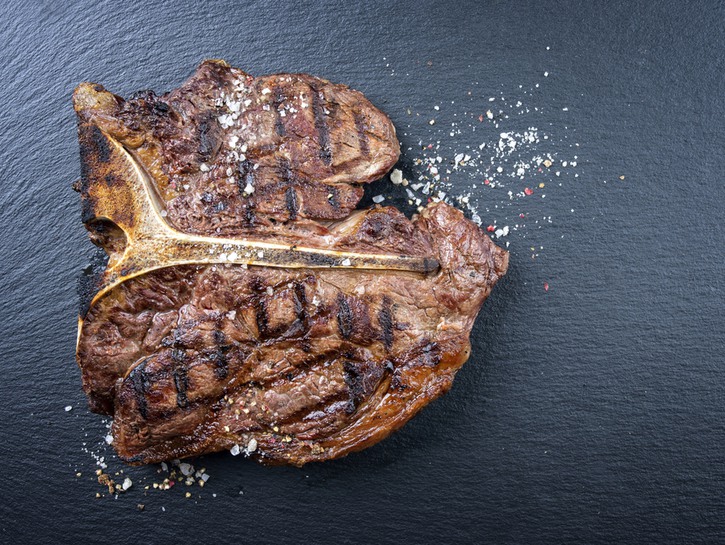Choosing the right steak for dinner is a fun task for any home chef. Each cut of meat has different cooking times, varying levels of tenderness, and can be paired with different side dishes. Selecting the perfect cut of beef opens the door to a delicious meal… that is, once you’ve officially chosen which route to take. We’re here to take out some of the guesswork by introducing you to the porterhouse steak and all you need to know about it.
What Is A Porterhouse Steak?

A porterhouse is cut from the short loin of a cow and the USDA actually has very specific guidelines as to what makes this steak. According to them, the filet of a steak needs to be at least 1.25 inches thick when measured parallel to the length of the backbone. What this means is that the thickness is essentially measured at the cut’s widest point.
Given the overall size, a porterhouse is a large cut that’s often presented in restaurants as meals for two.
Porterhouse Versus T-Bone
Porterhouse and T-bone steaks are cut from the same part of a cow: the short loin. They each also have the telltale “T” shaped bone running through the cut. However, the similarities don’t stop there.

Technically speaking, the only difference between these two is the amount of meat. While a porterhouse needs to be at least 1.25 inches thick at its widest part, a T-bone only needs to be 0.25 inches thick at its widest part. However, there is a bit of a trick. If a T-bone steak reaches the required 1.25-inch thickness then it can be sold as a porterhouse. The chain goes like this:
- 1.25 inches is a porterhouse steak
- 0.25 – 1.24 inches is a T-bone steak
- A cut of beef under 0.25 inches is considered a club steak or a New York strip
These numbers also reveal that T-bones can be porterhouse steaks, but porterhouse steaks can’t be T-bones. If a steak ever falls short of the USDA guidelines, you don’t have a porterhouse.
Should I Choose A Porterhouse Steak?

If you’re hungry or looking for a juicy dinner for two, the porterhouse steak is your lady. The average porterhouse can range from 16 ounces to a whopping 40 ounces. On the bright side, if you’re not planning on sharing your steak, you’ll probably set some sort of record for red meat consumption (though we don’t endorse that).
Since this bad boy has so much meat on it, a properly grilled porterhouse will provide the out-of-body experience one can hope for in a steakhouse. The flavor brought about by a savory rub or marinade or basic steak seasoning makes this the go-to for beef lovers everywhere. And hey, you’ll always have leftovers.
Where To Buy A Porterhouse Steak
Steakhouses and butcher shops will sell you porterhouse cuts without an issue.
It’s important to note, though, that both the T-bone and porterhouse will cost you more. You’re getting more meat and more flavor, which means more money from your pocket. Chances are you’ll spend anywhere from $10.00 – $90.00 for a porterhouse, and even more if you’re indulging in a restaurant.
Tips To Prepare A Porterhouse Steak

Alright, enough talk. We’ve reviewed the difference between the cuts and you have your heart set on a porterhouse. Before you do anything, you’ll want to:
- Season the steak to your tastes (this can include a marinade or basic salt, pepper, and olive oil)
- Clean your grill or cookware to ensure your porterhouse doesn’t get stuck or taste of old dinners
Seasoning
Chefs have widely debated when to season a steak and how best to do it. Some argue that rubs and marinades make everything better, while others counter with three-ingredient seasoning.
Really, the best thing to do is to season a steak to your preferences. Some people don’t like to add pepper in marinades or hours before cooking because it could seep into the meat and burn when grilled. Other people don’t mind adding pepper beforehand because they enjoy the taste and don’t notice a burned flavor.
Similarly, some people believe that adding salt beforehand will dry out the steak. To avoid this, they season their meat right before cooking in order to avoid dryness. Others add salt hours in advance because a drier steak is best for proper browning.
The best thing you can do is season based on your preferences.
Cooking

Once you’ve made the proper preparations, you can prepare it however you like. Pan-fried, grilled, and broiled are all popular ways to get this big guy ready. That said, grilling your steak is probably the easiest method.
A huge part of preparing a steak to your tastes is deciding on doneness. While medium-rare is often sought after, you’ll need to prepare yourself before diving in. Generally speaking, 3-5 minutes per side will yield the perfect medium-rare steak, but those times differ depending on your cookware or stoves.
Final Notes
A porterhouse steak is a thick cut of beef best reserved for the hungriest of people. It bears many similarities to the T-bone, but at the end of the day, the porterhouse will offer much more meat. Bigger cuts come with bigger price tags, though, so be prepared for some expensive cuts when you visit your butcher.
With so many different articles and cookbooks telling you different things, preparing a steak to your personal tastes is the way to go. In the end, your dinner is your own and seasoning meat how you like will make the experience better for you.
